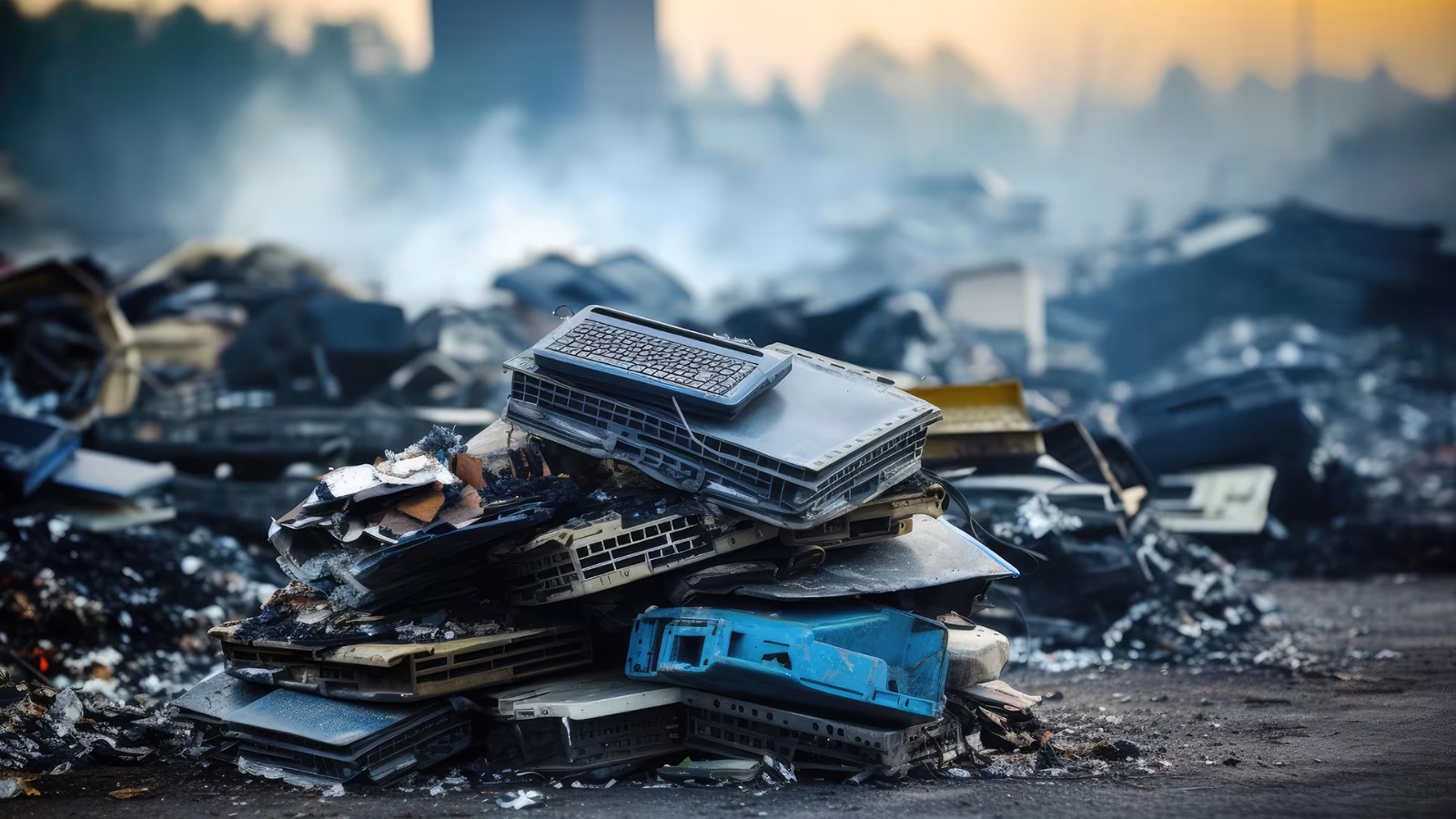
Smart Buildings of the Future: How Technology Protects Us from Natural Disasters
Smart buildings of the future combine AI, IoT, sensors, and advanced materials to create safer, more resilient spaces. They detect natural disasters early, monitor structural health in real-time, and guide occupants during emergencies. Automated energy management, predictive analytics, and innovative construction techniques reduce damage and save lives.
✨ Raghav Jain

Introduction
As climate change intensifies, natural disasters such as earthquakes, floods, hurricanes, and wildfires are becoming more frequent and destructive. Traditional buildings often struggle to withstand these extreme events, putting human lives and property at risk. This is where smart buildings of the future come into play—integrating cutting-edge technology, artificial intelligence, and sustainable design to protect us during natural disasters.
Smart buildings are not just about automation or convenience—they are designed to anticipate risks, respond in real time, and minimize damage. By leveraging sensors, resilient materials, and predictive systems, these structures safeguard occupants while ensuring business continuity and urban resilience.
In this article, we’ll explore how technology transforms buildings into protective environments, the science behind these innovations, practical features, and how they are shaping the future of urban safety. In recent years, the world has witnessed a significant increase in the frequency and intensity of natural disasters, from earthquakes and hurricanes to floods and wildfires. These events not only threaten human life but also cause substantial economic losses and disrupt daily life. As urban populations grow and cities expand vertically, the need for structures that can withstand the forces of nature has become more critical than ever. Smart buildings, integrating advanced technologies and data-driven systems, are emerging as a vital solution to protect inhabitants and assets from natural disasters, offering a blend of safety, efficiency, and resilience.
At the core of smart buildings is the use of advanced sensors and real-time monitoring systems. These sensors, embedded within the structure, constantly track environmental conditions such as temperature, humidity, wind speed, seismic activity, and water levels. For instance, seismic sensors can detect minute tremors and vibrations in a building, allowing early warnings for potential earthquakes. When connected to a centralized system, these sensors enable predictive analysis, alerting occupants and authorities before a disaster escalates. By anticipating hazardous events, smart buildings can initiate preemptive measures, such as shutting down utilities, activating emergency lighting, or guiding occupants to safe zones, significantly reducing the risk of injury or property damage.
The integration of artificial intelligence (AI) and machine learning further enhances the protective capabilities of smart buildings. AI algorithms analyze historical data from past disasters and current sensor readings to forecast potential threats and optimize responses. For example, in regions prone to flooding, AI can predict water intrusion based on rainfall patterns, river levels, and drainage system capacity. Automated systems can then respond by sealing vulnerable entrances, activating pumps, or rerouting drainage to mitigate damage. In hurricane-prone areas, AI can assist in adjusting structural elements like windows, shutters, or retractable facades to withstand high winds. This proactive approach ensures that smart buildings are not merely passive structures but active participants in disaster prevention.
One of the most promising aspects of smart buildings is their resilience through adaptive design. Traditional buildings are often rigid and static, making them vulnerable when forces exceed their structural limits. Smart buildings, however, incorporate dynamic architectural elements capable of responding to environmental stress. For instance, some skyscrapers are designed with tuned mass dampers, massive counterweights that shift to counteract swaying during earthquakes or strong winds. Advanced materials such as shape-memory alloys, impact-resistant glass, and self-healing concrete further improve structural durability. By combining material science with responsive design, smart buildings can endure and recover from extreme events more effectively than conventional constructions.
Communication technology also plays a crucial role in disaster management within smart buildings. Internet of Things (IoT) networks connect various systems, from fire alarms and elevators to HVAC and lighting, allowing seamless coordination during emergencies. In the event of a disaster, occupants receive real-time updates through smartphones, wearable devices, or public announcement systems, guiding them toward safe evacuation routes. Moreover, smart buildings can communicate with city-wide emergency response systems, providing valuable data on occupancy levels, structural integrity, and areas of damage. This information enables first responders to prioritize resources and make informed decisions, enhancing overall community resilience.
Energy management is another critical feature that contributes indirectly to disaster protection. Smart buildings often rely on renewable energy sources such as solar panels or energy storage systems that ensure functionality during power outages, a common occurrence during natural disasters. Backup power allows critical systems like water pumps, fire suppression systems, elevators, and communication networks to continue operating, maintaining safety and comfort for occupants. Furthermore, energy-efficient designs reduce the overall load on municipal power grids, which can be overwhelmed during extreme events, contributing to broader disaster resilience at the urban level.
The concept of predictive maintenance is equally important in safeguarding smart buildings. Traditional maintenance relies on scheduled inspections, which may miss hidden vulnerabilities that could become catastrophic during a disaster. Smart buildings employ continuous monitoring to detect structural stress, corrosion, or system malfunctions before they escalate. For example, if sensors detect a weakening in a load-bearing beam, automated alerts can prompt immediate repairs or temporary reinforcement, preventing potential collapse during an earthquake. This approach not only enhances safety but also reduces long-term maintenance costs by addressing issues before they become severe.
Smart buildings also improve human safety through automated evacuation systems. In emergency situations, elevators, doors, and staircases can be programmed to operate optimally, guiding occupants along the safest routes while minimizing congestion. AI-driven simulations can predict human movement patterns during disasters, optimizing escape routes and reducing panic-induced accidents. Furthermore, integration with wearable devices or smart IDs can help track individuals’ locations, ensuring that everyone is accounted for and that vulnerable populations, such as the elderly or disabled, receive priority assistance.
Beyond immediate protection, smart buildings contribute to long-term urban resilience. They provide valuable data for city planners and disaster management authorities, revealing patterns of vulnerability and infrastructure weaknesses. This information can inform the design of new buildings, public spaces, and emergency protocols, creating safer cities that are better equipped to face the challenges posed by climate change and natural disasters. In this sense, smart buildings are not isolated entities but integral components of a broader strategy for urban safety and sustainability.
In conclusion, smart buildings of the future represent a fusion of technology, architecture, and human-centric design aimed at minimizing the impact of natural disasters. By leveraging sensors, AI, adaptive materials, IoT networks, and predictive maintenance, these structures actively monitor, respond, and adapt to environmental threats. They not only safeguard lives and property but also support broader urban resilience by providing data and maintaining critical services during emergencies. As natural disasters become increasingly frequent and severe, the adoption of smart building technologies will be essential for creating safer, more resilient communities, transforming the way we live, work, and protect ourselves in an unpredictable world.
Understanding Smart Buildings and Disaster Preparedness
Smart buildings are structures equipped with advanced technologies that monitor, automate, and optimize operations. When applied to disaster preparedness, they focus on resilience, real-time response, and risk mitigation.
Key components include:
- Sensors & IoT Devices: Monitor structural integrity, weather conditions, and occupancy patterns.
- Automated Systems: Control emergency lighting, alarms, ventilation, and evacuation procedures.
- AI & Predictive Analytics: Analyze data to forecast disaster impact and optimize response.
- Resilient Materials: Shock-absorbing foundations, fire-resistant panels, and flood-proof barriers.
A disaster-ready smart building aims to:
- Detect risks before they escalate
- Alert occupants instantly
- Minimize structural damage
- Maintain critical services (electricity, water, communication)
- Facilitate rapid recovery post-event
How Smart Technology Protects Against Natural Disasters
1. Earthquakes
Smart buildings use seismic sensors and dampers to reduce shaking impact. These systems detect tremors and activate shock absorbers, isolating vibrations to prevent structural collapse. AI-driven models can also predict aftershocks and adjust building systems to ensure safety.
2. Floods
Buildings in flood-prone areas integrate water-resistant barriers, smart drainage, and flood sensors. When sensors detect rising water levels, automated pumps activate, floors are sealed, and alerts notify occupants. Some designs even include floating or elevated structures to stay above floodwaters.
3. Hurricanes & Strong Winds
Smart facades and reinforced windows automatically adjust during high winds, minimizing pressure damage. AI-powered weather systems predict storms and trigger automated shutters, roof locks, and emergency power backup.
4. Fires
Integrated heat sensors, smoke detectors, and automated sprinklers can detect fire early and activate containment systems. Smart ventilation controls smoke flow, while AI guides evacuation by monitoring safe routes in real time.
5. Power Outages & Communication Breakdowns
Smart grids and backup energy storage ensure critical systems remain operational during disasters. IoT devices maintain communication between emergency teams and building occupants, even during blackouts.
Daily Practices and Features for Disaster-Ready Smart Buildings
- Regular Sensor Checks: Ensure smoke detectors, seismic sensors, flood alarms, and temperature monitors are functioning.
- Automated Evacuation Drills: Scheduled simulations familiarize occupants with escape routes and emergency protocols.
- Smart Lighting & Signage: Illuminated pathways automatically guide people during power failures or smoke events.
- Water Management: Smart meters detect leaks or rising water levels, automatically activating pumps or sealing zones.
- Communication Alerts: Occupants receive instant push notifications or voice alerts on emergencies via connected apps.
Weekly and Monthly Safety Enhancements
- AI Analytics Review: Evaluate structural stress data, hazard patterns, and past alerts to optimize disaster response.
- Battery and Backup Maintenance: Ensure energy storage units and backup generators are fully functional.
- Smart Locks & Access Control Checks: Test automated locks, emergency exits, and fire doors for smooth operation.
- Emergency Kit Replenishment: Smart buildings monitor stocks of first-aid kits, fire extinguishers, water, and emergency rations.
- Virtual Drills: AI-assisted evacuation simulations predict best routes and improve response times for all occupants.
Innovative Smart Building Technologies for Disaster Protection
- IoT Sensors & Real-Time Monitoring: Track structural vibrations, water levels, and air quality.
- Predictive AI: Uses historical data and weather forecasts to warn residents before a disaster strikes.
- Smart Dampers & Foundations: Absorb energy from earthquakes or strong winds.
- Adaptive Facades & Roofs: Automatically change shape or close openings to resist storms and wind damage.
- Emergency Energy Systems: Solar panels with battery storage provide uninterrupted power.
- Augmented Reality Evacuation Maps: AR apps guide occupants to safe zones in real time.
- Automated Fire Suppression: Combines sprinklers, smoke extraction, and safe exits controlled through AI.
Disaster-Specific Design Principles
- Flood-Resistant Materials: Non-porous concrete, water-repellent coatings, elevated electrical panels.
- Earthquake-Resilient Structures: Base isolation pads, cross-laminated timber, reinforced steel frames.
- Wind-Resistant Designs: Rounded corners, aerodynamic rooftops, hurricane-proof glazing.
- Fire-Resistant Features: Sprinkler networks, fire doors, heat-reflective paints, and compartmentalized interiors.
Common Misconceptions About Smart Buildings and Disaster Safety
“Smart buildings are only for luxury skyscrapers.”
→ False! IoT and AI solutions are increasingly scalable for offices, schools, hospitals, and residential complexes.
“Technology can prevent all disaster damage.”
→ Not true. Smart systems reduce risk and protect lives, but they cannot make buildings invincible.
“Manual evacuation is no longer needed.”
→ Wrong. Smart buildings enhance evacuation, but human guidance and drills remain crucial.
“Retrofit buildings cannot become smart.”
→ Completely false. Many older structures can be upgraded with sensors, alarms, and adaptive systems for disaster preparedness.
“Only tech-savvy people benefit from smart buildings.”
→ Not true. Automation and AI operate seamlessly in the background, requiring minimal intervention from occupants.
Sample Daily Routine for Disaster-Ready Smart Building Management
Morning:
- Conduct quick sensor diagnostics for fire, flood, and earthquake alerts
- Check automated lighting, smart doors, and emergency routes
Afternoon:
- AI system updates weather forecast and potential hazard alerts
- Maintenance of water and power systems
Evening:
- Conduct virtual evacuation simulation for staff or residents
- Test emergency communication devices and backup energy
Weekly:
- Review structural health analytics from sensors
- Replenish emergency supplies
- Test smart facades, dampers, and ventilation systems
Monthly:
- Update predictive AI software and integrate new hazard data
- Conduct full-scale evacuation drill
- Check battery backup and IoT connectivity across the building
Benefits of Smart Buildings in Disaster Scenarios
- Enhanced Safety: Early alerts, automated response systems, and evacuation support save lives.
- Damage Reduction: Smart materials and adaptive technologies minimize structural and asset damage.
- Energy Continuity: Backup energy systems keep essential services running.
- Rapid Recovery: AI analytics and real-time monitoring accelerate rebuilding and restore normal operations faster.
- Peace of Mind: Occupants feel safe and reassured knowing the building adapts proactively to hazards.
Conclusion
The future of urban living lies in smart buildings designed for resilience. These structures combine AI, IoT, predictive analytics, and disaster-resistant materials to protect both lives and property. While no technology can completely eliminate natural disaster risks, smart buildings significantly reduce harm and improve response efficiency.
From earthquake-resistant foundations to flood sensors, AI-powered evacuation systems, and automated energy backups, these buildings represent a new era of safety and innovation. Adopting smart building practices ensures that cities, offices, and homes are not only convenient but also resilient against the growing threat of natural disasters.
Whether you’re an architect, urban planner, or concerned homeowner, investing in smart building technology today will save lives and protect communities tomorrow. Start small with sensors and automated systems, then expand to adaptive structures and AI-driven analytics.
Smart buildings don’t just shelter us—they actively safeguard our future.
Q&A Section
Q1:- What are smart buildings and how do they differ from traditional buildings?
Ans :- Smart buildings integrate sensors, IoT, and automation systems to monitor and manage energy, security, and structural health in real‑time, unlike traditional buildings which rely on manual operations.
Q2:- How do smart buildings detect natural disasters early?
Ans :- Advanced sensors and IoT networks monitor environmental parameters like earthquakes, floods, storms, and fires, providing early warnings and triggering automated safety responses.
Q3:- What role does AI play in enhancing building safety during disasters?
Ans :- AI analyzes real‑time data from sensors, predicts structural risks, and coordinates emergency protocols, reducing damage and ensuring occupant safety.
Q4:- How does IoT improve disaster preparedness in smart buildings?
Ans :- Connected devices communicate with each other and external networks, enabling automated alerts, evacuation guidance, and resource management during emergencies.
Q5:- What materials and construction techniques make smart buildings more resilient?
Ans :- Smart buildings use high‑strength concrete, flexible frameworks, shock-absorbing materials, and modular designs to withstand earthquakes, floods, and high winds.
Q6:- How do smart energy systems contribute to disaster management?
Ans :- Automated energy management ensures uninterrupted power supply, integrates backup generators, and prioritizes critical systems during emergencies.
Q7:- What is the role of real-time monitoring in maintaining safety?
Ans :- Continuous monitoring detects structural weaknesses, water leakage, fire hazards, and air quality issues, allowing preventive action before disasters escalate.
Q8:- How do smart buildings help during evacuations?
Ans :- Automated systems guide occupants with digital signage, emergency lighting, and voice alerts, optimizing evacuation routes and reducing panic.
Q9:- How does predictive analytics enhance disaster resilience?
Ans :- By analyzing historical data and environmental trends, predictive analytics forecasts potential disasters and recommends structural or operational adjustments proactively.
Q10:- What future technologies could further improve smart building safety?
Ans :- Integration of robotics, drone surveillance, augmented reality for emergency planning, and AI-driven disaster simulations will make smart buildings even safer and more adaptive
Similar Articles
Find more relatable content in similar Articles

E-Waste Crisis: The Race to Bu..
The rapid growth of electronic.. Read More

Digital India: How Technology ..
Digital India leverages techn.. Read More

The Dark Web Economy: What’s R..
Beneath the surface of the int.. Read More

The Death of the Charging Port..
“As technology evolves, the tr.. Read More
Explore Other Categories
Explore many different categories of articles ranging from Gadgets to Security
Smart Devices, Gear & Innovations
Discover in-depth reviews, hands-on experiences, and expert insights on the newest gadgets—from smartphones to smartwatches, headphones, wearables, and everything in between. Stay ahead with the latest in tech gear
Apps That Power Your World
Explore essential mobile and desktop applications across all platforms. From productivity boosters to creative tools, we cover updates, recommendations, and how-tos to make your digital life easier and more efficient.
Tomorrow's Technology, Today's Insights
Dive into the world of emerging technologies, AI breakthroughs, space tech, robotics, and innovations shaping the future. Stay informed on what's next in the evolution of science and technology.
Protecting You in a Digital Age
Learn how to secure your data, protect your privacy, and understand the latest in online threats. We break down complex cybersecurity topics into practical advice for everyday users and professionals alike.
© 2025 Copyrights by rTechnology. All Rights Reserved.